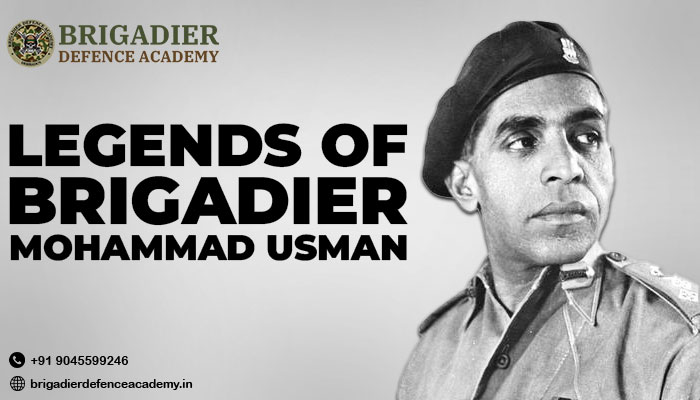Brigadier Mohammad Usman, famously known as the “Lion of Nowshera,” is a towering figure in the history of the Indian Army. His story is a blend of unmatched valor, selfless patriotism, and strategic brilliance. The life of Brigadier Mohammad Usman and his legends of war have continued to inspire generations of Indians and military personnel alike. In this blog, we delve into the rich legacy, contributions, and heroic tales of one of India’s most decorated war heroes.
Early Life and Education
Born on July 15, 1912, in Azamgarh, Uttar Pradesh, Brigadier Mohammad Usman came from a deeply principled and religious family. His father, Mohammad Farooq Khunambir, was a well-respected police officer. From a young age, Usman displayed discipline, dedication, and a profound sense of duty. He was determined to serve his country and joined the Royal Military Academy, Sandhurst, in the United Kingdom—a prestigious institution that trained many of India’s early military leaders.
In 1934, he was commissioned into the Baluch Regiment of the British Indian Army. Following India’s independence, when the division of regiments took place between India and Pakistan, Brigadier Usman made a monumental decision. Despite being offered the highest post in the Pakistani Army by Muhammad Ali Jinnah, he refused the offer and chose to stay with India. This decision would set the stage for the rest of the life of Brigadier Mohammad Usman and his legends of war.
Post-Independence Turmoil and Decision
After independence, the newly born nations of India and Pakistan were grappling with several political and territorial challenges. One of the most contentious was the status of the princely state of Jammu and Kashmir. When tribal militias from Pakistan, supported by the Pakistani Army, invaded Kashmir in 1947, Brigadier Usman was called upon to defend the Indian territory.
The Battle of Nowshera: A Defining Moment
The most significant chapter in the life of Brigadier Mohammad Usman and his legends of war unfolded during the Indo-Pak war of 1947-48. Brigadier Usman was commanding the 50 (Independent) Parachute Brigade in Jammu and Kashmir. The Pakistani Army and Pashtun tribal fighters launched an offensive to capture strategic areas in Kashmir, especially targeting Nowshera in the Rajouri district.
Despite being outnumbered and under-equipped, Brigadier Usman held his ground. His brigade successfully defended Nowshera against relentless attacks from the enemy. His rallying cry to his men was, “Do not retreat an inch. Fight to the last man and the last bullet.” Under his leadership, the Indian Army repelled wave after wave of assaults.
The defense of Nowshera was one of the turning points in the war. It not only bolstered Indian morale but also marked the beginning of Pakistan’s retreat in many key sectors. Brigadier Usman’s leadership earned him widespread respect and admiration, both among his troops and senior officers. The event became central to the life of Brigadier Mohammad Usman and his legends of war.
Sacrifice and Martyrdom
Brigadier Usman continued to lead from the front even as threats to his life increased. On July 3, 1948, just days before his 36th birthday, he was killed in an enemy shelling in Jhangar, another strategically important location. His death was a huge blow to the Indian Army and the nation. Brigadier Usman was posthumously awarded the Maha Vir Chakra (MVC), India’s second-highest wartime gallantry award.
His funeral was conducted with full state honors. Prime Minister Jawaharlal Nehru and other national leaders attended his funeral. He was buried at the Jamia Millia Islamia campus in New Delhi, a solemn testament to his legacy.
Legacy and National Reverence
The life of Brigadier Mohammad Usman and his legends of war are immortalized in Indian military history. His choice to remain loyal to India despite the lure of high office in Pakistan is celebrated as a symbol of patriotism. His bravery in battle and commitment to duty have made him a role model for officers and soldiers in the Indian Army.
Numerous institutions and roadways have been named in his honor, including the Brigadier Usman Road in Delhi. His tomb is a site of national importance and serves as a place of reflection for military personnel and civilians alike.
Inspiration for Future Generations
The life of Brigadier Mohammad Usman and his legends of war are taught in military academies and commemorated on significant days such as Independence Day and Republic Day. His story is also included in Indian history textbooks, reminding young students of the cost of freedom and the valor it demands.
Brigadier Usman continues to be a symbol of courage beyond religion and regional identities. At a time when communal tensions were rife, his actions demonstrated what it meant to be an Indian first. His secularism, commitment, and heroism are deeply woven into the Indian Army’s ethos.
Lesser-Known Facts
- He was the highest-ranking officer of the Indian Army to be killed in action during the 1947-48 war.
- He often spent time with his soldiers and ensured they were well-fed and morally uplifted.
- Despite his seniority, he frequently joined frontline soldiers, risking his life.
- The enemy had placed a bounty of Rs. 50,000 on his head due to his effectiveness in battle.
Conclusion
The life of Brigadier Mohammad Usman and his legends of war represent the finest traditions of the Indian Army—selflessness, bravery, and unshakeable commitment to the nation. From his early days in Azamgarh to his heroic last stand in Jhangar, Brigadier Usman lived and died for India. His story is not just about military triumph but about the soul of a soldier who put his country above everything else.
India will always remember Brigadier Mohammad Usman not just as a war hero but as a national icon of loyalty and valor.
Follow the The Devbrat Sir Code channel on WhatsApp to know about more inspiring journeys: https://whatsapp.com/channel/0029Va5H6or8F2p777rpcQ2m
FAQs on the Life of Brigadier Mohammad Usman
- Who was Brigadier Mohammad Usman? Brigadier Mohammad Usman was a decorated Indian Army officer known as the “Lion of Nowshera” for his heroic role in the 1947-48 Indo-Pak war.
- Why is Brigadier Usman called the ‘Lion of Nowshera’? He earned the title for bravely defending Nowshera against overwhelming Pakistani forces, playing a key role in India’s military success during the conflict.
- What award did Brigadier Mohammad Usman receive for his bravery? He was posthumously awarded the Maha Vir Chakra, India’s second-highest military decoration for acts of gallantry during wartime.
- Where is Brigadier Mohammad Usman buried? He is buried at the Jamia Millia Islamia campus in New Delhi, where his tomb remains a site of national reverence.
- What is the significance of the life of Brigadier Mohammad Usman and his legends of war? His life is a symbol of patriotism, secularism, and courage, and continues to inspire generations of Indians and members of the armed forces.







